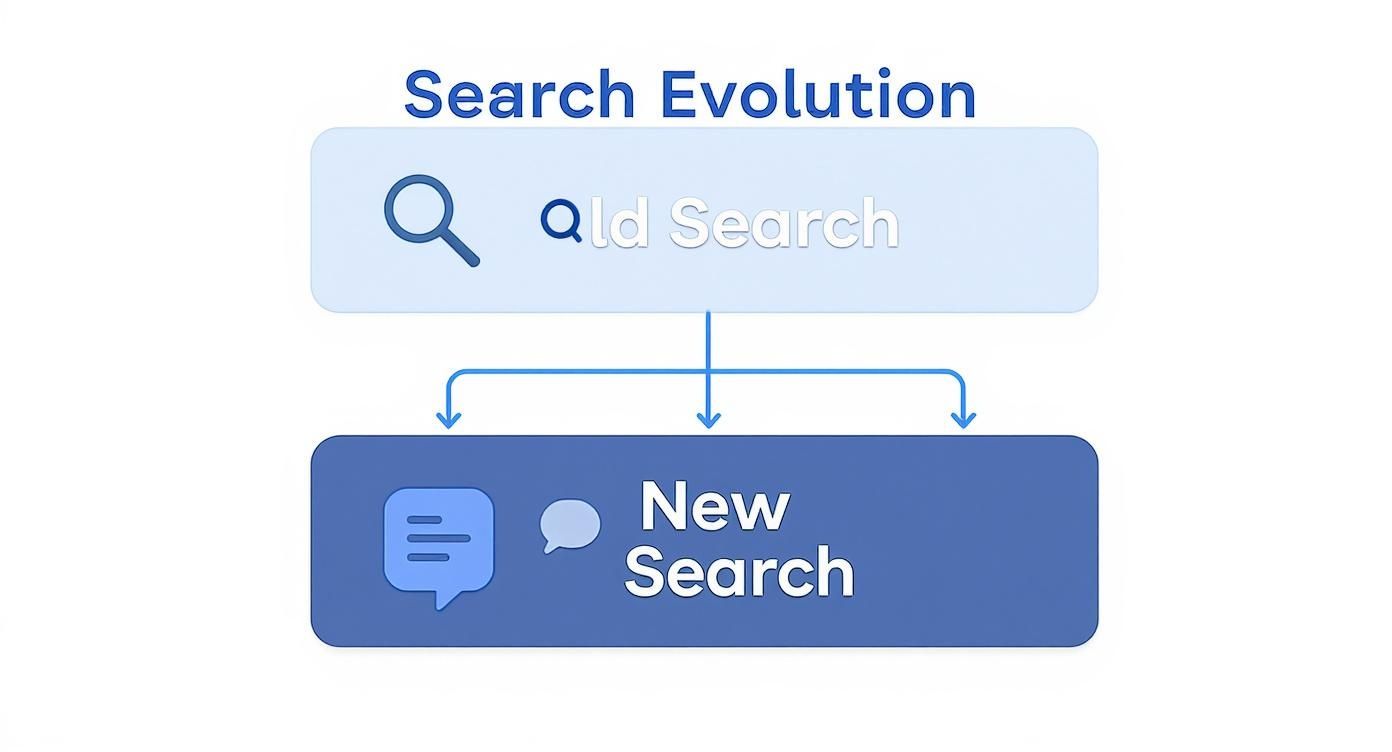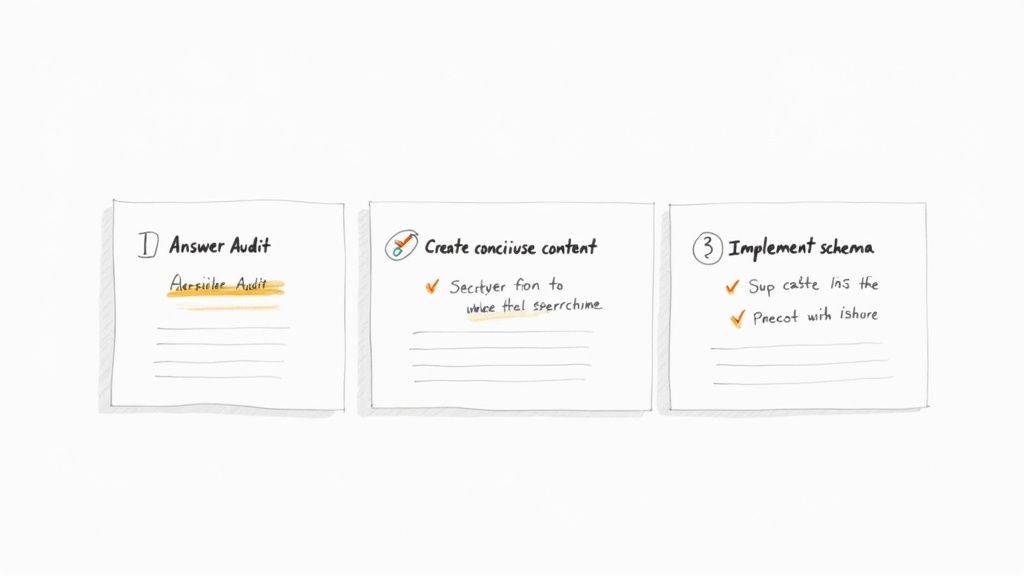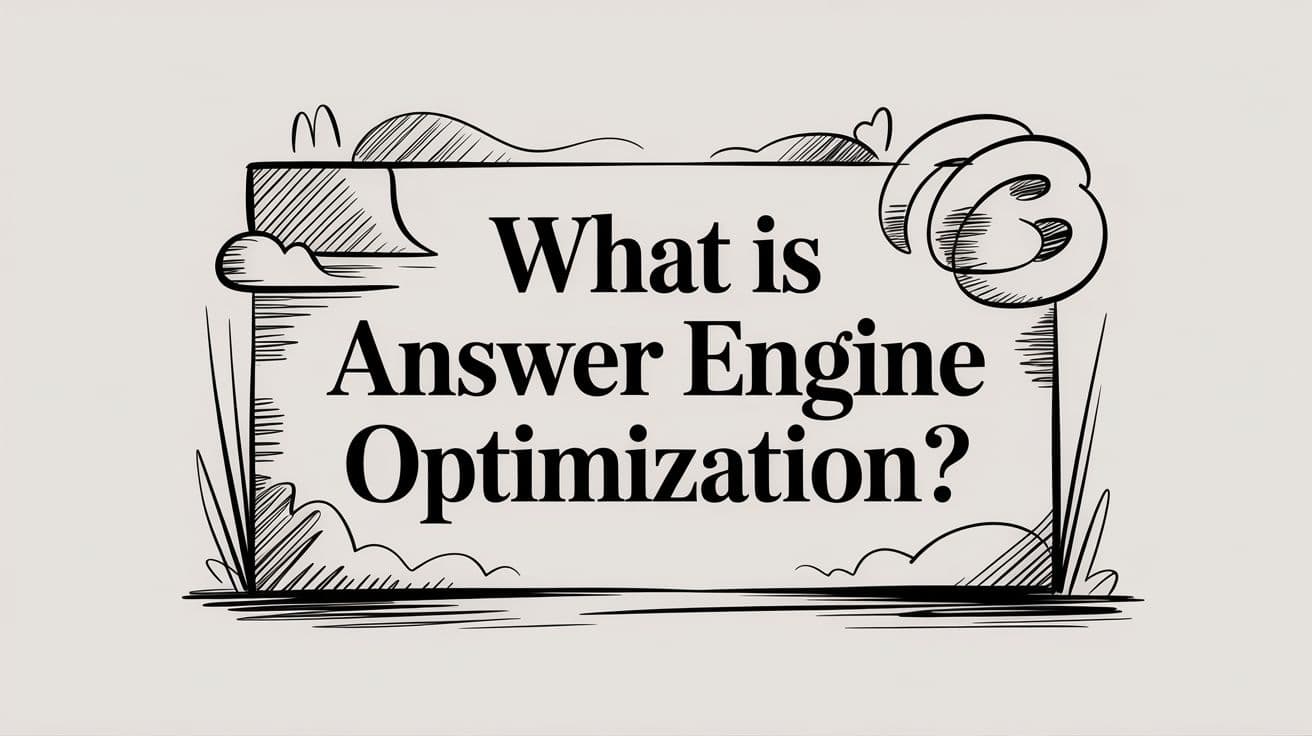Answer Engine Optimization (AEO) is the practice of crafting content so it becomes the direct, authoritative source for AI-powered answers on platforms like ChatGPT and Google's AI Overviews. The goal is no longer just to rank your links. It's to be the answer that an AI chooses to deliver.
This is a fundamental shift from the old SEO playbook.
The Search Bar Is Dead, and You Need a New Strategy
People are changing how they find information. They're ditching fragmented keywords and asking full, conversational questions to AI assistants. This change means your old SEO tactics are becoming obsolete.
Traditional SEO was like having a great sign on a busy street to attract foot traffic. AEO is like being the trusted expert the city planner calls whenever a complex question arises. If an AI doesn't see you as that expert, you are invisible to a massive, growing audience.
To understand this shift, it's helpful to see the evolutionary journey of Search Engine Marketing and how it led us here.
From Keywords to Conversations: The Numbers Don't Lie
This isn't a future trend; it's happening now. Projections from TNG Shopper (2024) show that conversational AI search is set to explode by 300% in 2024 alone. Platforms like ChatGPT, Perplexity, and Google’s AI Overviews are on track to handle over 500 billion queries annually.
The core problem is simple: AI assistants are the new front page of the internet. If your brand isn't cited in their answers, you don't exist for users asking high-intent questions. This is the exact problem AEO solves.
This visual breaks down the evolution from the old keyword model to the new conversational one.

As you can see, the game has moved from simple word matching to understanding and answering complex, natural language questions.
Why Your SEO Playbook Is Failing in the Age of AI
For years, the goal was simple: get the #1 link. But what happens when the page has fewer links to click? This is the zero-click reality answer engines are creating.
Old-school metrics like keyword density and raw backlink volume don't work here. Those tactics were designed to win a race for clicks, not to provide definitive answers. AI models don't just count keywords; they evaluate the quality and clarity of your information. If you’re still focused only on traditional SEO, your brand will be left out of the conversation.

The Pivot from Gaming Algorithms to Informing Them
Instead of outdated metrics, answer engines look for signals that prove your content is trustworthy and machine-readable. This is the key difference between AI SEO vs. traditional SEO—the focus shifts from gaming an algorithm to genuinely informing it.
The signals that matter most now are:
- E-E-A-T (Experience, Expertise, Authoritativeness, and Trustworthiness): AI wants to cite sources that are verifiably credible. It's not just what you say, but who you are.
- Structured Data: Using schema markup is like giving an AI a roadmap to your content. It clarifies context, making your information much easier to parse and feature as a direct answer.
- Concise, Factual Content: Your writing must be direct. Answer the question clearly without the fluff.
AEO demands a pivot from a technical, link-focused game to a strategy centered on providing clear, verifiable, expert-driven information. Failing to make this shift means you’re optimizing for a world that no longer exists.
The 3 Pillars of a Winning AEO Strategy
How do you get an AI to cite your content? It comes down to three pillars that shift your focus from chasing rankings to providing clear, machine-readable expertise. This isn't about loopholes; it's about structuring your knowledge so AI models can digest and trust it.

Mastering AEO means mastering these three areas. If one pillar weakens, your content becomes far less likely to be cited as a definitive source.
1. Structure Your Content for Machines
First, you must speak the AI’s language. This means using structured data and semantic HTML. When you implement schema markup like FAQPage or HowTo, you're adding a hidden layer of context that tells an answer engine exactly what your content is and what it does.
This technical layer acts like a perfectly labeled file folder. It lets an AI instantly recognize that a specific piece of text is a direct answer to a question. For a deeper look at the technical side, explore more about SEO for AI.
2. Write Factual and Concise Answer Blocks
Next, your writing style must adapt. AI models aren't looking for long narratives. They hunt for concise, factual content blocks that directly answer a query.
Think of every piece of content as a collection of answer modules.
- Be Direct: State the answer in the first one or two sentences.
- Be Factual: Back up claims with data that can be verified.
- Be Clear: Use simple language and cut the jargon.
This "inverted pyramid" style makes it incredibly easy for an AI to lift your text, present it as an answer, and credit your brand as the source.
3. Build Unmistakable Topical Authority
Finally, AEO demands a serious commitment to building deep topical authority. It's not enough to target a single keyword. You need to cover an entire subject comprehensively, answering every related question your audience has.
Healthline is a master of this. Ask an AI a medical question, and Healthline is almost always cited. Why? Because they've built a massive library of well-structured, expert-reviewed content. AI models see this depth and reward it with trust. This authority signals to answer engines that you aren't just a source—you are the source.
How Winning Brands Get Cited by AI
Theory is fine, but seeing AEO in action makes it real. Winning this game isn’t about a secret formula. It's about a relentless focus on clarity, structure, and user intent. Smart brands are already using AI tools for business growth to shape their AEO strategy.
Here’s how two different businesses are earning valuable AI citations.
Mini Case Study 1: The Niche Financial Blog
A small advisory blog wanted to reach freelancers asking complex retirement questions. They knew this audience used AI assistants for high-stakes financial advice.
They shifted their content strategy away from long, narrative posts.
- Question-Based Headers: Every H2 became a specific question, like "What Is The Best Retirement Savings Strategy For Freelancers?"
- Data-Backed Snippets: Each section began with a direct, data-supported answer. No fluff.
- Structured Glossaries: They added a simple glossary of financial terms marked up with schema, making it simple for an AI to pull clean definitions.
The result? They began appearing in AI-generated answers for niche financial queries. This drove highly qualified leads by establishing them as a trusted authority. This approach is also a key piece of the puzzle if you're trying to figure out how to rank in ChatGPT.
Mini Case Study 2: The Ecommerce Cookware Store
An online store selling high-end pans faced a different problem: how to reach customers before they were ready to buy.
Their solution was to become the definitive expert on using their products.
They built detailed FAQ sections on product pages and published "how-to" guides for questions like, "How do you properly season a carbon steel pan?" This transformed their product pages from sales listings into indispensable resources. AI models started citing their guides as the definitive answers, funneling users with high purchase intent directly to the correct product page.
They didn't just sell a pan; they sold the expertise on how to use it perfectly.
Is AEO Just a Buzzword? Look at the Data.
Does Answer Engine Optimization actually move the needle? The data is clear. AEO isn't just about brand awareness; it builds trust and authority at the exact moment a customer is looking for help.
When an AI like ChatGPT cites your brand, it's a powerful endorsement that traditional advertising can't buy. This has a direct impact on your bottom line, because the traffic from these citations is highly qualified and closer to converting.
From Citation to Conversion: The Real ROI
Companies that adopted AEO strategies early are already seeing results. According to one 2024 industry analysis, organizations with dedicated AEO efforts captured 3.4 times more answer engine traffic than competitors.
And this isn't vanity traffic.
- Sources cited by answer engines see a 27% higher conversion rate on click-throughs.
- Engagement metrics from this traffic are 31% higher than from traditional search visitors.
You can dig into more stats that prove why AEO is crucial for growth. In plain English, AEO delivers a more engaged audience that converts at a higher rate. Being the cited source makes you the authority, building brand equity and opening a direct path to revenue.
Your First Steps in Answer Engine Optimization
Ready to start? The good news is that AEO isn't a massive site overhaul. It's about making smart, targeted adjustments. This checklist can be woven directly into your existing content workflow.

Treat this as an ongoing cycle, not a one-time task.
An Actionable AEO Checklist for Your Next Article
- Run an 'Answer Audit': Find the top 20-30 questions your customers are actually asking. Dig into your site search data, customer service logs, and Google's "People Also Ask" boxes. These are your targets.
- Create (or Update) Answer Blocks: For each question, create a dedicated page or content block that gives a direct, authoritative answer. Start the section with a concise answer, then provide supporting details and data.
- Implement Basic Schema: Give answer engines the structural clues they need. Start simple with
FAQPageandArticleschema. They are straightforward to implement and give AI models immediate context.
This approach ensures you’re not just writing articles, but building structured answer assets that build authority over time. Don't forget that classic SEO and AEO are connected—pages ranking in the top 10 are five times more likely to get cited by an answer engine. To see how intertwined they are, check the latest SEO and AEO statistics.
Your AEO Questions, Answered
Here are straight answers to the most common questions about Answer Engine Optimization.
How long does AEO take to show results?
While traditional SEO can take 6-12 months to show movement, you can often see the first signs of AEO working within 2-4 months. AI models are faster at indexing and rewarding well-structured, authoritative content. However, building the deep topical authority needed to dominate competitive queries is still a long-term commitment.
Do I need to be a developer to do AEO?
No. The core of AEO is creating high-quality, direct, and authoritative content—a skill for writers and strategists. That said, technical elements like schema markup provide a massive advantage. Many CMS platforms like WordPress have plugins that make adding basic schema easy, no developer needed. It's a skill worth learning.
Is AEO the new SEO?
Think of it as an evolution, not a replacement. AEO is a specialized layer you build on top of a solid SEO foundation. You can't succeed at AEO without strong fundamentals like:
- E-E-A-T (Experience, Expertise, Authoritativeness, Trustworthiness)
- A mobile-friendly site with a great user experience
- Fast page load speeds
Your AEO efforts will fail on an unhealthy site. The two must work together. For a deeper dive on this strategic shift, check out HubSpot's community discussion on SEO and content strategy.
Take the Next Step
The first step to winning in AEO is knowing where you stand. Stop guessing and start measuring. See exactly where your brand appears in AI-generated answers on platforms like ChatGPT and Perplexity. Identify the prompts your customers are asking and get an actionable plan to earn more citations.
Start optimizing for the future of search at https://aiseotracker.com.

